-
 Bitcoin
Bitcoin $106,754.6083
1.33% -
 Ethereum
Ethereum $2,625.8249
3.80% -
 Tether USDt
Tether USDt $1.0001
-0.03% -
 XRP
XRP $2.1891
1.67% -
 BNB
BNB $654.5220
0.66% -
 Solana
Solana $156.9428
7.28% -
 USDC
USDC $0.9998
0.00% -
 Dogecoin
Dogecoin $0.1780
1.14% -
 TRON
TRON $0.2706
-0.16% -
 Cardano
Cardano $0.6470
2.77% -
 Hyperliquid
Hyperliquid $44.6467
10.24% -
 Sui
Sui $3.1128
3.86% -
 Bitcoin Cash
Bitcoin Cash $455.7646
3.00% -
 Chainlink
Chainlink $13.6858
4.08% -
 UNUS SED LEO
UNUS SED LEO $9.2682
0.21% -
 Avalanche
Avalanche $19.7433
3.79% -
 Stellar
Stellar $0.2616
1.64% -
 Toncoin
Toncoin $3.0222
2.19% -
 Shiba Inu
Shiba Inu $0.0...01220
1.49% -
 Hedera
Hedera $0.1580
2.75% -
 Litecoin
Litecoin $87.4964
2.29% -
 Polkadot
Polkadot $3.8958
3.05% -
 Ethena USDe
Ethena USDe $1.0000
-0.04% -
 Monero
Monero $317.2263
0.26% -
 Bitget Token
Bitget Token $4.5985
1.68% -
 Dai
Dai $0.9999
0.00% -
 Pepe
Pepe $0.0...01140
2.44% -
 Uniswap
Uniswap $7.6065
5.29% -
 Pi
Pi $0.6042
-2.00% -
 Aave
Aave $289.6343
6.02%
Is the sharp drop after the high cross star the peak? Do I have to run?
A sharp drop after a high cross star in crypto charts may signal a potential market reversal, prompting traders to reassess their positions.
Jun 20, 2025 at 11:14 am
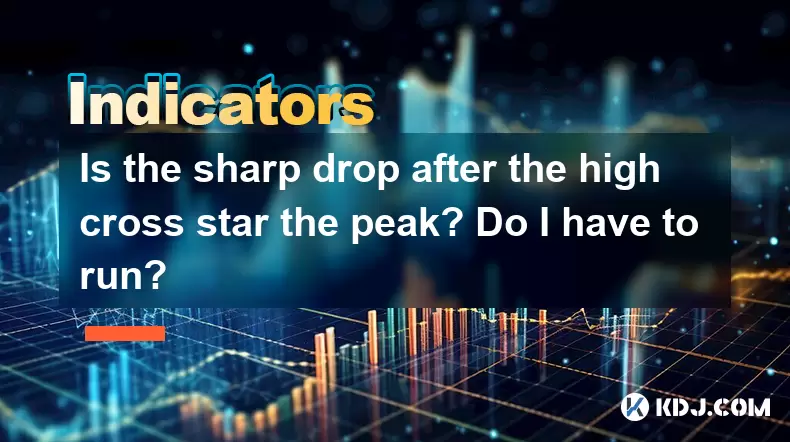
What is a High Cross Star in Cryptocurrency Charts?
In the realm of technical analysis, especially within cryptocurrency trading, the high cross star is a candlestick pattern that often catches the attention of traders. It typically forms after a significant upward trend and signals potential weakness in the market. The pattern consists of a large bullish candle followed by a small-bodied candle with long upper and lower shadows, resembling a cross or inverted cross.
The appearance of this formation may suggest indecision among traders, as buyers and sellers battle for control. When this occurs at a resistance level or near previous highs, it raises concerns about whether the price has reached a peak. For many crypto investors, identifying such patterns becomes crucial when assessing risk and making decisions about holding or selling their assets.
How to Recognize a Sharp Drop After a High Cross Star
A sharp drop following a high cross star can be alarming for investors who are used to upward momentum. This sudden decline usually begins after the cross star candle closes, indicating that the bears have taken over from the bulls. To recognize this pattern effectively, traders should look for specific characteristics:
- A clear uptrend preceding the formation
- A candle with little or no real body, positioned above the trend
- A sharp decline in volume or momentum after the cross star appears
- Price dropping significantly below the cross star’s low within a few candles
When these conditions align, it strengthens the likelihood that the market has reached a short-term top. However, it's essential not to make impulsive decisions solely based on one candlestick pattern without considering broader market context and other technical indicators.
Does the High Cross Star Always Signal a Peak?
While the high cross star is often interpreted as a bearish reversal signal, it does not always mean that the price has peaked. In some cases, the market may consolidate or even resume its upward movement after a brief pullback. Therefore, relying solely on this pattern could lead to premature exits or missed opportunities.
Traders should consider using additional tools such as moving averages, RSI (Relative Strength Index), and Fibonacci retracement levels to confirm the strength of the reversal. If the RSI dips below 50 and starts trending downward, or if key support levels break, then the probability of a genuine peak increases. Conversely, if the price holds above critical levels and volume remains strong, the cross star might simply indicate a pause rather than a reversal.
Should You Sell Immediately After a Sharp Drop?
Deciding whether to sell after observing a sharp drop following a high cross star depends on several factors unique to each investor. Risk tolerance, investment strategy, and overall market conditions play a vital role in shaping this decision.
For short-term traders, particularly those engaged in swing trading or day trading, recognizing such a reversal might justify exiting a position quickly to lock in profits. They might set stop-loss orders just below the cross star’s low to manage downside risk effectively.
Long-term holders, however, may view this as a temporary correction within a broader uptrend. If fundamental aspects of the cryptocurrency remain strong—such as network growth, adoption, or positive developments—it may still be prudent to hold. These investors often wait for clearer signs of a downtrend before making any moves.
Alternative Strategies Instead of Panic Selling
Instead of immediately running for the exits upon spotting a sharp drop after a high cross star, traders can explore alternative strategies to manage their exposure:
- Partial profit-taking: Sell a portion of your holdings to secure gains while keeping the rest in case the rally resumes.
- Trailing stops: Use dynamic stop-loss mechanisms that adjust as the price moves, allowing you to protect profits without prematurely exiting.
- Hedging: Consider hedging positions using options or inverse ETFs (where available) to mitigate downside risk without liquidating assets entirely.
- Dollar-cost averaging out: Gradually reduce your position over time instead of selling all at once, which can help average out exit prices.
These strategies provide flexibility and allow investors to respond thoughtfully rather than react emotionally to short-term volatility.
Frequently Asked Questions
Q: Can the high cross star appear during a downtrend?
Yes, although it is more commonly associated with topping patterns in an uptrend, the high cross star can also form during a downtrend. In such cases, it may act as a potential reversal signal known as a "low cross star" or hammer, suggesting possible bullish sentiment returning to the market.
Q: How reliable is the high cross star compared to other candlestick patterns?
The high cross star is considered moderately reliable but works best when confirmed by other indicators or chart patterns. Compared to patterns like engulfing candles or head and shoulders formations, it may require additional confirmation before being fully trusted as a reversal signal.
Q: Is it possible to automate detection of the high cross star in crypto charts?
Yes, many modern trading platforms and algorithmic systems offer candlestick pattern recognition features. Traders can set up alerts or use scripts to detect occurrences of the high cross star automatically across various cryptocurrencies and timeframes.
Q: How long should I wait after seeing a sharp drop post-high cross star before making a move?
There is no fixed timeframe, but waiting for at least two to three confirming candles after the high cross star can increase the accuracy of the signal. Monitoring volume and other technical indicators during this period will help determine whether the reversal is legitimate or just a temporary pullback.
Disclaimer:info@kdj.com
The information provided is not trading advice. kdj.com does not assume any responsibility for any investments made based on the information provided in this article. Cryptocurrencies are highly volatile and it is highly recommended that you invest with caution after thorough research!
If you believe that the content used on this website infringes your copyright, please contact us immediately (info@kdj.com) and we will delete it promptly.
- Cardano, Dogecoin, and the Altcoin Shift: What's Next?
- 2025-06-20 22:45:12
- Gold Coin, Rare, Horses: A Numismatic Roundup
- 2025-06-20 22:45:13
- Dogecoin, Shiba Inu, and the Meme Coin Mania: What's Next?
- 2025-06-20 22:25:12
- GateToken (GT) Price Prediction: Navigating 2025-2030 with a New Yorker's Sass
- 2025-06-20 23:05:13
- Pepe, Price Prediction, and Elon Musk: A NYC Take on the Frog Coin Frenzy
- 2025-06-20 23:05:13
- Core Scientific (CORZ): Needham's Price Target and the Bitcoin Mining Upside
- 2025-06-20 22:25:12
Related knowledge

Does the sudden contraction of ATR indicate the end of the trend?
Jun 20,2025 at 11:14pm
Understanding ATR and Its Role in Technical AnalysisThe Average True Range (ATR) is a technical indicator used to measure market volatility. Developed by J. Welles Wilder, ATR calculates the average range of price movement over a specified period, typically 14 periods. It does not indicate direction—only volatility. Traders use ATR to gauge how much an ...

Is the golden cross of the ROC indicator below the zero axis effective?
Jun 20,2025 at 09:42pm
Understanding the ROC Indicator and Its Role in Cryptocurrency TradingThe Rate of Change (ROC) indicator is a momentum oscillator widely used by traders to assess the speed at which cryptocurrency prices are changing. It measures the percentage difference between the current price and the price from a certain number of periods ago. The ROC helps identif...
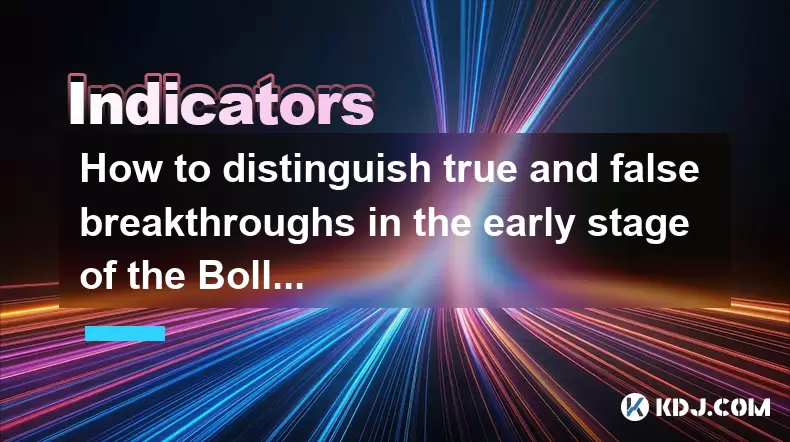
How to distinguish true and false breakthroughs in the early stage of the Bollinger Band opening?
Jun 20,2025 at 10:35pm
Understanding the Bollinger Band StructureBollinger Bands consist of three lines: a simple moving average (SMA) in the middle, and two outer bands that are standard deviations away from the SMA. These bands expand and contract based on market volatility. When the bands begin to widen, it often signals an increase in price volatility, which traders inter...
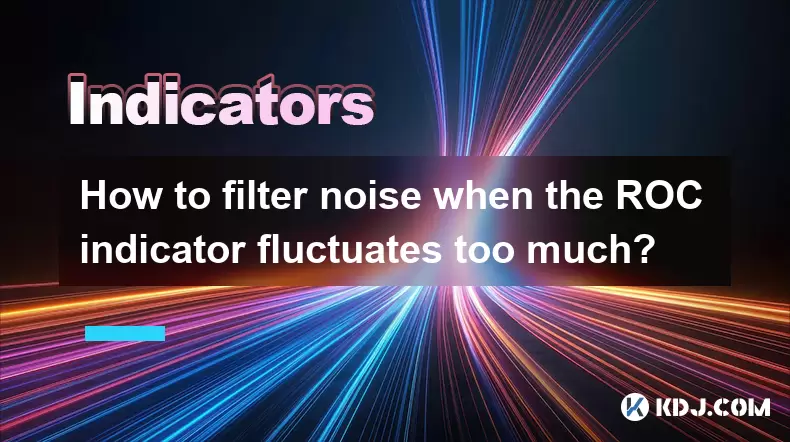
How to filter noise when the ROC indicator fluctuates too much?
Jun 20,2025 at 11:07pm
Understanding the ROC Indicator and Its SensitivityThe Rate of Change (ROC) indicator is a momentum oscillator that measures the percentage change in price between the current closing price and the closing price from a specified number of periods ago. When the ROC indicator fluctuates too much, it can create misleading signals, especially in volatile or...
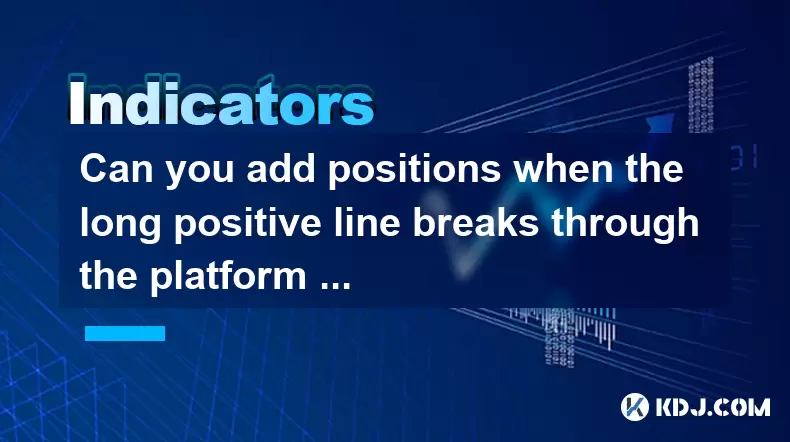
Can you add positions when the long positive line breaks through the platform and then shrinks and falls back?
Jun 20,2025 at 08:57pm
Understanding the Price Pattern: Breakthrough, Retract, and ConsolidationIn cryptocurrency trading, one of the commonly observed patterns involves a long positive line breaking through a consolidation platform, followed by a retraction or pullback. This scenario often raises questions among traders about whether to add positions after such a move. The p...
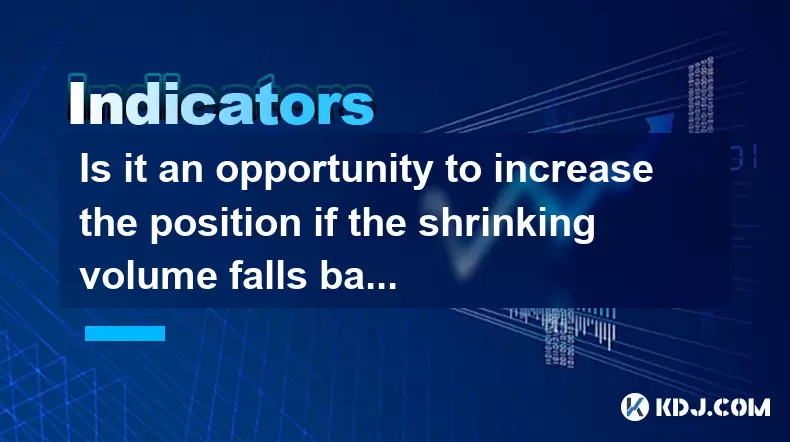
Is it an opportunity to increase the position if the shrinking volume falls back to the rising trend line?
Jun 20,2025 at 06:22pm
Understanding the Shrinking Volume in Cryptocurrency TradingIn cryptocurrency trading, volume is one of the most critical indicators used to confirm price movements and trends. When traders observe a scenario where volume shrinks during a pullback, it can signal either a lack of selling pressure or an imminent reversal. This phenomenon often occurs when...

Does the sudden contraction of ATR indicate the end of the trend?
Jun 20,2025 at 11:14pm
Understanding ATR and Its Role in Technical AnalysisThe Average True Range (ATR) is a technical indicator used to measure market volatility. Developed by J. Welles Wilder, ATR calculates the average range of price movement over a specified period, typically 14 periods. It does not indicate direction—only volatility. Traders use ATR to gauge how much an ...

Is the golden cross of the ROC indicator below the zero axis effective?
Jun 20,2025 at 09:42pm
Understanding the ROC Indicator and Its Role in Cryptocurrency TradingThe Rate of Change (ROC) indicator is a momentum oscillator widely used by traders to assess the speed at which cryptocurrency prices are changing. It measures the percentage difference between the current price and the price from a certain number of periods ago. The ROC helps identif...

How to distinguish true and false breakthroughs in the early stage of the Bollinger Band opening?
Jun 20,2025 at 10:35pm
Understanding the Bollinger Band StructureBollinger Bands consist of three lines: a simple moving average (SMA) in the middle, and two outer bands that are standard deviations away from the SMA. These bands expand and contract based on market volatility. When the bands begin to widen, it often signals an increase in price volatility, which traders inter...

How to filter noise when the ROC indicator fluctuates too much?
Jun 20,2025 at 11:07pm
Understanding the ROC Indicator and Its SensitivityThe Rate of Change (ROC) indicator is a momentum oscillator that measures the percentage change in price between the current closing price and the closing price from a specified number of periods ago. When the ROC indicator fluctuates too much, it can create misleading signals, especially in volatile or...

Can you add positions when the long positive line breaks through the platform and then shrinks and falls back?
Jun 20,2025 at 08:57pm
Understanding the Price Pattern: Breakthrough, Retract, and ConsolidationIn cryptocurrency trading, one of the commonly observed patterns involves a long positive line breaking through a consolidation platform, followed by a retraction or pullback. This scenario often raises questions among traders about whether to add positions after such a move. The p...

Is it an opportunity to increase the position if the shrinking volume falls back to the rising trend line?
Jun 20,2025 at 06:22pm
Understanding the Shrinking Volume in Cryptocurrency TradingIn cryptocurrency trading, volume is one of the most critical indicators used to confirm price movements and trends. When traders observe a scenario where volume shrinks during a pullback, it can signal either a lack of selling pressure or an imminent reversal. This phenomenon often occurs when...
See all articles

























































































